About The Area
Overview
The northern part of the Costa Blanca is known as La Marina and relates to the headland area which projects eastwards out towards Ibiza, the eastern most point being Cabo de la Nao which separates Javea and Moraira. La Marina itself is divided into La Marina Baja (lower and to the south) and La Marina Alta (upper and to the north).Both are in the Province of Alicante and the region of Comunidad Valencia.
La Marina Baja begins just north of Alicante at El Campello and coastwise extends to just north of Altea, then inland, in rough terms, along the mountain range starting with the Sierra Bernia and extending west to the Sierra de Serella, a little beyond Guadalest.
La Marina Alta This includes the resort towns of Calpe, Benissa-Costa, Moraira, Javea, and Denia to just south of Oliva. Inland the area extends to L’Orcha and encompasses the mountains and valleys of Jalon, L’aguart, D’Ebo, and Gallinera.
Geographic Notes
The Marina Alta Headland is best visualized as the right-hand side of a diamond, with Javea and Moraira just above and just below the easternmost point. This means that this area has the Mediterranean Sea surrounding about 270º of it. This stabilizing effect of the sea’s temperature ensures we have milder winters and more temperate summers compared to other coastal areas. The right side of the diamond consists of mountain ranges which represent a vast catchment for our year’s rainfall, which then flows into the low lying coastal areas via underground springs and reservoirs. So, although our rainfall is rather meagre the landscape is green and water shortages are extremely rare. The area is served by two international airports – Alicante and Valencia, each on average around an hour’s drive, via the A7/E15 Autovia which runs parallel to the coastline from past Gibraltar up to Calais.
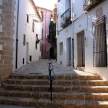
BENISSA is divided into two parts: the inland part which is more the administrative and commercial centre, and traditionally Spanish in its character; then Benissa Costa which is effectively a seamless, southerly extension of Moraira’s residential development. Between these two halves of Benissa is a stretch of campo (countryside) which has many nice fincas and country villas dotted about the vine terraces and citrus groves. Benissa represents the start of the serious hunting ground of quality villas which extends beyond Javea to Mount Montgo. There are many residential areas here; many with sea views, some close to beaches or the local golf course, others closer to the countryside. This is a mature and established area where past development has been nicely softened with established gardens and mature trees etc. Benissa enjoys the cache of neighbouring Moraira, but often at slightly lower prices
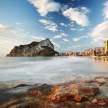
CALPE is midway between Altea and Moraira and is best known for its emblematic rock ‘Peñon de Ifach’ which separates Calpe’s two wonderful long sandy beaches. Calpe combines its town marina with its traditional fishing port which incorporates a row of adjacent fish restaurants offering a range of fresh fish and shellfish to match that of Brittany. The high rise nature of Calpe gives the town a ‘mini-Benidorm’ feel. There is a good selection of modern hotels here which attract a large number of holidaymakers and there is great family appeal in Calpe: its own Aitana department store is supported by many other fine shops whilst, away from the beaches, there is much to keep the children amused. Property-wise, most of the opportunities here are either apartments or linked villa/townhouse complexes. There are some areas of private villas, of particular note is the residential area leading down to the charming small harbour of Puerto Blanc.
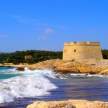
MORAIRA Now you have arrived! This ‘Jewell in the Costa Blanca crown’ has grown from a tiny fishing village into the most appealing and unspoilt town on the Costa Blanca. This has been achieved largely by strict planning controls regarding build density, reserved green areas and a limit of just four residential storeys for apartments which has created a distinctive ‘low-rise’ character to the town and surrounding area. The demand for property here remains strong and consistent and, given the very finite supply, and almost non-existence of building plots for additional development – this is very much blue chip investment territory! Geographically, Moraira is similar to Benissa in as much as it too has a typically Spanish inland twin town – Teulada, which is linked as one town in administrative terms. Also like Benissa, Moraira’s terrain is undulating hillside and slopes, with a broad valley sweeping through Teulada to meet the Mediterranean at Moraira’s shore. This valley adds further to Moraira’s distinctive character as, for several kilometres, this valley bottom consists of protected vineyards which extend down to the coastal road in the middle of town. The gentle slopes to both sides of this valley cradle a deceptive number of private villas, nestling between the pine trees and palms which help maintain a verdant and mellow feel to this residential landscape. Apart from the lack of high rise, the other feature lacking in Moraira is any significant number of hotels. This again, adds to Moraira’s special ‘feel’ – not only in structural terms – but the added bonus is that virtually, the only tourists who stay in Moraira are either villa owners or those privately renting villas; this also means that Moraira has a more stable, year-round population – not overrun in summer, not deserted in the winter. The quaint and typically Spanish original village lies between the marina and fishing harbour with its adjacent daily fish market, and the partially pedestrianized village centre, with its old church surrounded by pavement cafes and bars and a fine range of cosmopolitan shops and restaurants, to suit all tastes and budgets. Moraira has more than its share of beaches: sandy ones, together with many smaller pebble or rock beaches. Between the marina and the Cap D’or headland is the small bay of El Portet, with several small bar/restaurants along its small promenade. A nice refinement currently underway in Moraira is the project to remove all those unsightly electricity pylons, telegraph poles and their attached cables and replace them underground. Moraira-Teulada’s Ajuntamiento (local council) is (like the town itself) of a very cosmopolitan makeup (the deputy mayor is an English lady) and the income from the very modest local rates is used very effectively. Given the almost negligible instances of crime or vandalism, locally, we only seem to have to pay for things once here – nothing seems to be destroyed or stolen..
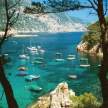
JAVEA is in many ways Moraira’s ‘big brother’. Lying in coastal terms, just round the corner of the Cabo de la Nao, from Moraira, Javea’s landscape is dominated by Mount Montgo (now designated ‘Parque Natural’), known locally as the ‘Elephant’s head’. Montgo is a small mountain of ‘Tosca’ stone – its distinctive ‘trunk’ extending to the sea at Cabo San Antonio where its subterranean progress continues beneath the Mediterranean before erupting to the surface as Ibiza (not a lot of people know this!) Tosca stone, originally quarried from the beaches of Javea in Roman times, and still featured in arches and pillars in local buildings and villas, until it was recently banned, is unique to just Javea and Ibiza. Javea’s discovery and development predates that of Moraira by just a few years, and has changed beyond recognition during the past forty years of its development. A kind of Spanish Dartmouth, the town has grown and developed in a ‘T’ shape, parallel to the coastline, and formed from three distinct areas. The left hand end of the head of the ‘T’ is the original old town, still retaining its Spanishness and perched at the top of a hill to protect its original inhabitants from pillaging Barbary pirates. This blends the commercial heart of the town within a tangle of quaint, narrow passageways and a permanent, covered market building close to the church square. The right end of the head of the ‘T’ is the harbour and marina, like Moraira, it has its own market with a daily fish auction but, unlike Moraira, the emphasis of the facility leans more towards its fishing origins, rather than as a haven for ‘yachties’. Moving back southwards, along the waterfront, just past the beachside Parador, is the Arenal beach a superb sandy bay with clusters of palm trees providing bathers with some essential shade. The length of the Arenal is lined with restaurants and shops, and both the Pueblo and the Puerto have their fair share of shops, bars and restaurants too. Between these three centres, from first-line seafront, back to the Pueblo many apartments have been built and there is much choice for all budgets and tastes. Beyond this triangle, are many developments of detached villas (as well as linked villas and townhouse complexes), available for all tastes, from €120,000 to €5m+. As with Moraira, many of these areas are now very mature, with the bulk of the properties partly obscured with greenery, low density development and plenty of protected green areas. The Pueblo has recently been subjected to three years of sustained infrastructural renewal (now completed) which has caused a certain amount of disruption, and has adversely affected local property values. At this point, this does represent something of a buying opportunity for those with a little foresight..
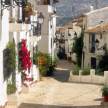
The Jalon Valley is on the Costa Blanca coast of Spain.
With some areas on the Costa Blanca coast becoming somewhat built up and overcrowded the Jalon Valley attracts a more discerning visitor and resident who appreciates more of a country feel although the coast and it’s beautiful beaches are still only 15 minutes’ drive away.
The Jalon Valley has some of the best scenery in Spain. There are magnificent mountains which surround the plains of olive trees, orange groves, vineyards and almonds.
Peppered in the Jalon Valley are unspoilt villages including Alcalali, Jalon, Lliber and Parcent, it is a walker’s paradise ranging from a very gentle stroll to a six hour walk around the Sierra Bernia mountains to the south of Jalon.
In late January and early February the whole of the Jalon Valley is covered with pink and white almond blossom and is the best time to see it.
THE TOWN OF JALON
The village of Jalon is at the heart of the Jalon Valley. At the Old Square there is a fountain around which there is an open market held on Tuesday mornings. Seen from the square is the famous Jalon Church with its blue dom and roaming around the many small streets, you will find an abundance of shops, bars and restaurants. Jalon is also very famous for its local wines. There are at bodegas (wine cellars) where you can sample the various types of wine before buying.
Jalon was under Arabic domination for over five hundred years. The Arabians built two castles, one for the Solana (the Aixa) and another in the Bernie. Both fortresses controlled the Jalon Valley and its numerous settlers. The Arabians left behind the typical house style, for which Jalon is famous today, i.e. houses of stone and old bricks with large wooden doors as well as decorated walls.
The Arabic culture influenced life in Jalon up to its final displacement in the year 1609. After that the trade with raisins became the major economic activity. Many farmers from Majorca settled in Jalon in the 18th and 19th centuries and started cultivating the land, concentrating on grapes for the production raisins.
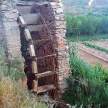
INLAND TOWNS. Within 15mins. drive of the coastline I have described above are to be found a plethora of very Spanish towns and villages. Whether they are perched atop mountains or cradled in valleys, they are all variations of the usual theme: narrow streets and passages radiating from the centrepiece of the church square, often a random blend of the ancient and traditional with post-civil war 1950s and 60s architecture, together with the contemporary. All but the most humble will boast a few bars, cafes and restaurants, a bakery, general store and pharmacy and have a weekly open market. Larger inland towns such as Jalon, Teulada, Benissa, Orba, Pedreguer etc. will be pretty well self- sufficient. Either attached to these little towns, or positioned somewhere between them there are a number of urbanizations (an ugly word – but it just means a properly coordinated development) both large and small. These provide a mix of modern accommodation built to current or recent European standards, with the peace and solitude of the otherwise untouched, Spanish countryside, usually with fabulous valley views and a dramatic mountain backdrop – at appreciably lower prices than their coastal counterparts. It would be impractical to attempt to capture in print the individual character and components of each of these towns and villages as there are literally hundreds of the blighters within the Marina Alta. The key inland focal points – south to north are:
- Benissa The inland part of Benissa Costa – between Calpe and Moraira, as mentioned above.
- Jalon Valley The wine producing valley consisting of: Senija, Lliber, Jalon, Alcalali & Parcent.
- Teulada & Benitachell Nice small towns, attached and/or associated with Moraira.
- Gata & Jesus Pobre Very Spanish villages, inland from Javea. Famous for its basketware and classical guitar makers.
- Orba & Murla At the epicentre of the Marina Alta – between the Grape and the Cherry valleys.
- Orba Valley, Vall de Laguart, Vall D’Ebo, Vall de Gallinera The cherry growing valleys – wonderful, but a little remote for some tastes!
- Pedreguer, Ondara, La Xara Self-contained small towns with satellite villages, inland from Denia
- Monte Pego & Cumbre del Sol Each are both large developments on their own hillsides, the former is between Pego and the coast, the latter is between and above Benitachell & Moraira. Both are equally suited for holiday homes or permanent living, each offering the cheapest sea views per €, in their respective areas..